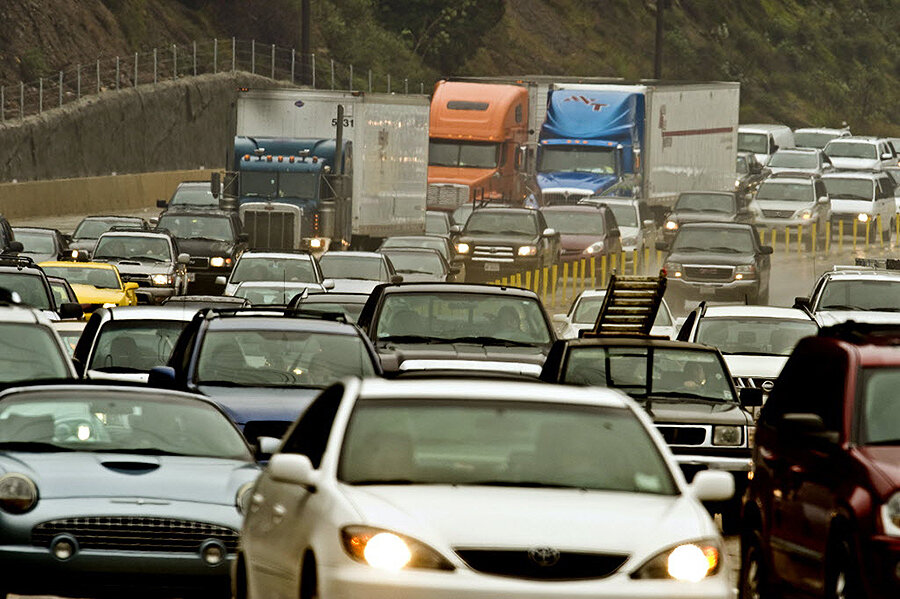L.A. has the world's worst traffic. How do we fix it?
Loading...
Are we there yet? If you’re a commuter in Los Angeles, the most likely answer is “not yet,” according to transportation analytics researcher INRIX.
When it comes to the sheer volume of time wasted in slow-moving traffic, L.A. tops INRIX’s recently released list of over 1,000 international cities, with 104 hours per driver. New York, San Francisco, Atlanta, and Miami join it in the top ten, giving the United States the dubious honor of having the worst traffic among rich developed countries.
Fortunately for US drivers, solutions addressing the problem at a number of levels are in the works.
To create the list, analytics research company based in Kirkland, Wash., crunched about 500 terabytes of data from 300 million sources around the world. Cities from several countries, however, including China, Japan, and Australia, were not included.
By another measure, some cities have it even worse than L.A. As a percentage of their driving time, drivers in Bogota, Colombia, spend the most time in traffic, with almost a third of their time on the road spent staring at the bumper of the next car, compared with just under 13 percent in L.A. Moscow commuters spend a quarter of their time similarly.
And the impact of traffic goes beyond drivers' moods. While its main drivers, according to INRIX, are positive indicators of economic growth, such as rising employment and falling gas prices, congestion also has a chilling effect on productivity.
The average US driver loses $1,200 a year in wasted time and gas money – even more in L.A. and the other cities at the top of the list. And that’s not to mention the effects on their employers.
The situation is likely to get worse before it gets better. As INRIX senior economist Bob Pishue explained to Forbes, “We’re seeing a definite impact of an improving economy on an already strained road system.”
“If those types of variables keep up we’ll likely see continued increases in congestion,” he added.
But relief might be on the way. The most cost-effective solution could be to harness the host of emerging distributed transportation services, and the explosion of available data that can help make commuting “smart.”
“We think most of the gains can be made through big data, smart parking solutions, for example. Up to 30% of urban traffic congestion in a downtown CBD [central business district] is related to the search for parking, so there’s a direct benefit in reducing that,” Mr. Pishue said. “Intelligent traffic signals are also relatively low cost, certainly less than adding a new lane of traffic, for a big benefit.”
True ride-sharing services are also on the rise. UberPOOL, Ford-owned Chariot, and Google navigation service Waze all offer carpool options that save riders money and get more cars off the road.
A pricier approach is to upgrade the country’s transportation systems directly. President Trump made large-scale infrastructure investment a cornerstone of his campaign, and in November, Los Angeles County voters approved a sales tax that may raise up to $120 billion for subway, light rail, and bus improvements over the next thirty years.
Some innovators are really thinking outside the box. While smart commuting and better infrastructure let cities use their road area more efficiently, using the vertical dimension could take that efficiency to a whole new level.
Last year, China test-drove a type of bus that beats traffic by driving over it, letting cars pass underneath. Such a system would take advantage of the roadways already in place, sidestepping the costs of excavating new subway tunnels.
But some dig the underground solutions. Transportation mogul Elon Musk, the chief executive of rocket company SpaceX and electric car company Tesla, may have set his sights on tunnels, as indicated by his tweet last December.
To the many who assumed the message was a joke, he followed it up with a clarifying tweet saying “I am actually going to do this,” and has updated his Twitter profile to summarize his interests as “Tesla, SpaceX, Tunnels & OpenAI.”
But Mr. Musk's fascination with tunnels is actually nothing new. In a 2015 interview with astrophysicist Neil DeGrasse Tyson, he said he would prefer to build more car tunnels, rather than have flying cars.
With "more car tunnels, then you would alleviate congestion completely. You would not need a flying car in that case," Musk said in Neil DeGrasse Tyson’s StarTalk radio show. "And it would always work, even if the weather is bad. It would never ice up, and it would never fall on your head."
Angelenos might not have long to wait. A January 25 tweet from Musk’s account suggests digging could begin as early as February or March.
Until then, drivers will have to make do with podcasts and Spotify.








